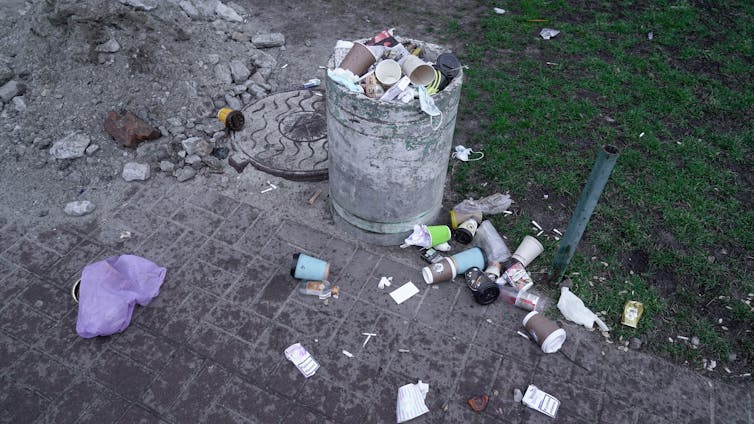Throughout the COVID-19 pandemic, masking has been one of the key public health measures put in place to combat the disease. Since March 2020, billions of disposable surgical masks have been used around the world, raising the question: What happens to all those used masks?
As researchers in single use plastic and microplastic pollution, the onset of a global wave of plastic debris pollution became evident to us in the early days of the pandemic — we could see the evidence even during lockdowns when exercise was limited to short daily walks in the neighbourhood. Masks and gloves were on the ground, fluttering in the wind and hanging on fencing.
As ecologists, we were also aware of where the debris would end up — in nests, for example, or wrapped around the legs or in the stomachs of wildlife.
In Canada, a team of researchers led by conservation biologist Jennifer Provencher studied how plastic debris impacts wildlife. In a study conducted during a canal cleanup in The Netherlands, biologists at the Naturalis Biodiversity Center documented that Personal Protective Equipment (PPE) debris would interact with wildlife in the same way as other plastics.
Effects on wildlife
There’s a cartoon circulating on the internet that goes like this: a rat comes home carrying bags of groceries to see two rats laying in bunk beds made from medical grade masks. The rat in the bottom bunk exclaims, “Free hammocks, all over town. It’s like a miracle!”
We shared this cartoon with our colleagues at the beginning of the pandemic, while we were conducting surveys of PPE litter around Toronto streets and parking lots.
We found that within the area that we were surveying — which covered an area of Toronto equivalent to about 45 football fields — over 14,000 disposable masks, gloves or hand wipes accumulated by the end of the year. That’s a lot of rat hammocks.
We set out to understand the breadth of the harm that PPE is doing to wildlife. What we learned is just how many other people were equally concerned.
Jarring images
We conducted a global survey using social media accounts of wildlife interactions with PPE debris. The images are jarring: A hedgehog wrapped in a face mask, the earloops tangled in its quills. A tiny bat, with the earloops of two masks wrapped around its wing. A nest, full of ivory white eggs, insulated with downy feathers and a cloth mask.
Many of these animals are dead, but most were alive at the time of observation. Some were released from their plastic entanglement by the people who captured the photo.
In total, we found 114 cases of wildlife interactions with PPE debris as documented on social media by concerned people around the world. Most of the wildlife were birds (83 per cent), although mammals (11 per cent), fish (two per cent), invertebrates such as an octopus (four per cent) and sea turtles (one per cent) were also observed.
The majority of observations originated in the United States (29), England (16), Canada (13) and Australia (11), likely representing both the increase in access to mobile devices and our English-language search terms. Observations also came from 22 other countries, with representation from all continents except Antarctica.
Weighing costs and benefits
With an estimated 129 billion face masks used monthly around the world, how do we, as ecologists and environmental researchers, tell a global population experiencing a global pandemic to use fewer masks? We don’t.
N95 masks have been essential in reducing the transmission of COVID-19 and, although they are more environmentally harmful than cloth masks, the benefit to health is demonstrably superior.
So, what could we have done better? One thing we noted during our PPE litter surveys is the abundance of discarded masks and gloves in close proximity to public garbage bins.
We hypothesize that a lack of clear messaging from municipalities and provinces about safe ways to dispose of PPE, along with our reluctance to gather near sources of discarded PPE, may have contributed to this global pollution event.

(Shutterstock)
These are lessons that can still be implemented as we continue to cycle through waves of this pandemic; the use of masks is not yet behind us. Our surveys continue as we track an accumulation of PPE debris that will likely find its way into more nests and tangled around the bodies of more animals.
The rise of single use plastic use due to COVID-19 may not have been avoidable. But the rise in plastic pollution could have been mitigated with some investment in public outreach and modifications to waste management infrastructure to allow for masks and other PPE to be disposed of and processed correctly with minimal leakage to the environment.